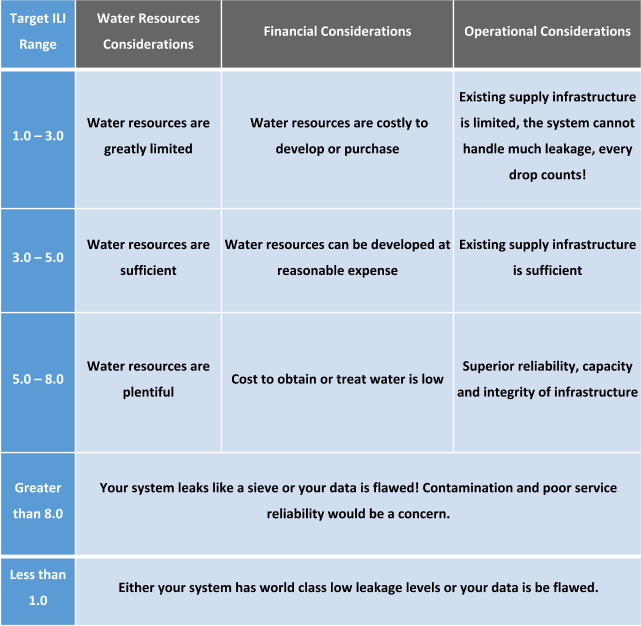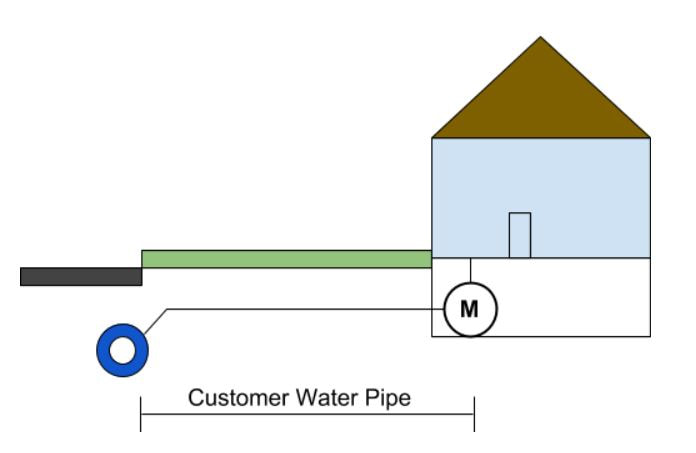*New* System Correction Factor (SCF) for the UARL
The original UARL equation was developed by the 1st IWA Water Loss Task Force, 1995-99. Allan Lambert, the equation's originator, has developed a system correction factor SCF for the UARL. This correction factor takes into account the relationship between pipe material and pressure and burst frequency differences with system size. See https://www.wlranda.com/software/uarl-with-scf-us-units/ for more information.
The SCF improves the accuracy of the UARL, especially for small systems <5,000 connections.
The original UARL equation was developed by the 1st IWA Water Loss Task Force, 1995-99. Allan Lambert, the equation's originator, has developed a system correction factor SCF for the UARL. This correction factor takes into account the relationship between pipe material and pressure and burst frequency differences with system size. See https://www.wlranda.com/software/uarl-with-scf-us-units/ for more information.
The SCF improves the accuracy of the UARL, especially for small systems <5,000 connections.
Water Audit Concepts and Definitions
Apparent Losses: Unauthorized consumption, all types of customer metering inaccuracies, and systematic data handling errors in customer billing operations.
Authorized Consumption: Volume of metered and/or unmetered water taken by registered customers, the water supplier and others who are implicitly or explicitly authorized to do so by the water supplier, for residential, commercial and industrial purposes. = Billed Water Exported + Billed Metered + Billed Unmetered + Unbilled Metered + Unbilled Unmetered Consumption
Current Annual Real Losses (CARL): The annual volumes lost through all types of leaks and breaks in water mains and service connections, up to the point of customer metering. Real losses also include overflows and leaks from treated water storage tanks.
Infrastructure Leakage Index (ILI): The ILI is calculated by dividing Current Annual Real Losses (CARL) by UARL. (ratio of CARL to UARL) The ILI is the best performance indicator for bench marking leakage within an individual water provider because it is a dimensionless performance indicator. An ILI close to “1” indicates the utility’s Real Losses are close to the UARL and therefore further reductions in Real Water Losses might be unattainable or uneconomical. The ILI target range table located below to help goal setting.
Non-Revenue Water: The sum of Water Losses plus Unbilled Authorized Consumption. The term Non-Revenue Water should be used instead of the imprecise term unaccounted-for water. It is recognized that some of this component water of Non-Revenue water is authorized consumption (unbilled).
Unavoidable Annual Real Losses (UARL): Reported in gallons, based on miles of mains, number of service connections, total length of customer service connection pipe from curb stop to customer meter, and average system pressure. The UARL is a theoretical reference value representing the technical low limit of leakage that would exist in a distribution even if all of today’s best leakage control technology could be successfully applied in that system. The UARL is not a performance indicator but is used as the denominator in calculating the Infrastructure Leakage Index (ILI). No system can achieve zero water loss because water distribution systems are not perfectly sealed. The UARL is a system-specific calculation that varies among systems, the calculation is below.
UARL (gallons) = (5.41Lm + 0.15Nc + 7.5Lc) X P X D
Lm = length of mains (miles)
Nc = number of customer service connections
Lc = total length of customer service connection piping (miles) - See below for a diagram
Lc = Nc X (Lp/5280)
Lp = the average distance of customer service connection piping (feet) - This is usually 0, unless customer meters are not at the property line
P = Pressure (psi)
D = Number of days from time period
Water Audit: A water audit is an accounting of all of the water in a water system resulting in a quantified understanding of the integrity of the water system and its operation. It is the first step in formulating an economically sound plan to address water losses.
Water Losses: The difference between System Input Volume and Authorized Consumption, consisting of Apparent Losses and Real Losses.
Water Supplied: The sum volumes of water supplied to the system including water pumped from well sources, water from a treatment plant, water from spring sources and bulk water purchases. Basically this is the sum of the treated/potable water supplied to the water system.
Notes on UARL and ILI: Current AWWA water audit software does not calculate a UARL for systems with less than 3,000 service connections, however the UARL and ILI metrics have proven useful for small water systems internationally. This is the note from AWWA regarding the UARL calculation: “The UARL calculation has not yet been proven fully effective for very small or very low pressure water systems.“ AWWA software will not calculate a UARL if:
(Lm x 32) + Nc < 3,000
Or
P < 35 psi
Where Lm = length of mains, Nc = number of customer service connections P = average system pressure.
However, recent research in Europe suggests the UARL calculation can be valid for small systems, less than 3,000 services, these systems can achieve ILIs less than 1.0. This is due to several possible reasons which can occur separately or together:
The factors listed above can lead to an overestimated CARL, even if no systematic errors, especially for small water systems.
Small water systems, less than 5,000 service connections, are potentially able to achieve an ILI of 1 or less. This is due to the ability to have a “tighter” systems. Leaks and breaks are able to be identified and fixed more quickly than a larger system. If a small system has a significant line break the operator is able to notice changes to their system very quickly such as: lower pressure, pumps running more often or storage tank levels dropping. The operator of a small system will often times need to find and fix the break for the system to maintain operations.
For more information please see:
https://www.leakssuitelibrary.com/low-ilis-and-small-systems
Apparent Losses: Unauthorized consumption, all types of customer metering inaccuracies, and systematic data handling errors in customer billing operations.
Authorized Consumption: Volume of metered and/or unmetered water taken by registered customers, the water supplier and others who are implicitly or explicitly authorized to do so by the water supplier, for residential, commercial and industrial purposes. = Billed Water Exported + Billed Metered + Billed Unmetered + Unbilled Metered + Unbilled Unmetered Consumption
Current Annual Real Losses (CARL): The annual volumes lost through all types of leaks and breaks in water mains and service connections, up to the point of customer metering. Real losses also include overflows and leaks from treated water storage tanks.
Infrastructure Leakage Index (ILI): The ILI is calculated by dividing Current Annual Real Losses (CARL) by UARL. (ratio of CARL to UARL) The ILI is the best performance indicator for bench marking leakage within an individual water provider because it is a dimensionless performance indicator. An ILI close to “1” indicates the utility’s Real Losses are close to the UARL and therefore further reductions in Real Water Losses might be unattainable or uneconomical. The ILI target range table located below to help goal setting.
Non-Revenue Water: The sum of Water Losses plus Unbilled Authorized Consumption. The term Non-Revenue Water should be used instead of the imprecise term unaccounted-for water. It is recognized that some of this component water of Non-Revenue water is authorized consumption (unbilled).
Unavoidable Annual Real Losses (UARL): Reported in gallons, based on miles of mains, number of service connections, total length of customer service connection pipe from curb stop to customer meter, and average system pressure. The UARL is a theoretical reference value representing the technical low limit of leakage that would exist in a distribution even if all of today’s best leakage control technology could be successfully applied in that system. The UARL is not a performance indicator but is used as the denominator in calculating the Infrastructure Leakage Index (ILI). No system can achieve zero water loss because water distribution systems are not perfectly sealed. The UARL is a system-specific calculation that varies among systems, the calculation is below.
UARL (gallons) = (5.41Lm + 0.15Nc + 7.5Lc) X P X D
Lm = length of mains (miles)
Nc = number of customer service connections
Lc = total length of customer service connection piping (miles) - See below for a diagram
Lc = Nc X (Lp/5280)
Lp = the average distance of customer service connection piping (feet) - This is usually 0, unless customer meters are not at the property line
P = Pressure (psi)
D = Number of days from time period
Water Audit: A water audit is an accounting of all of the water in a water system resulting in a quantified understanding of the integrity of the water system and its operation. It is the first step in formulating an economically sound plan to address water losses.
Water Losses: The difference between System Input Volume and Authorized Consumption, consisting of Apparent Losses and Real Losses.
Water Supplied: The sum volumes of water supplied to the system including water pumped from well sources, water from a treatment plant, water from spring sources and bulk water purchases. Basically this is the sum of the treated/potable water supplied to the water system.
Notes on UARL and ILI: Current AWWA water audit software does not calculate a UARL for systems with less than 3,000 service connections, however the UARL and ILI metrics have proven useful for small water systems internationally. This is the note from AWWA regarding the UARL calculation: “The UARL calculation has not yet been proven fully effective for very small or very low pressure water systems.“ AWWA software will not calculate a UARL if:
(Lm x 32) + Nc < 3,000
Or
P < 35 psi
Where Lm = length of mains, Nc = number of customer service connections P = average system pressure.
However, recent research in Europe suggests the UARL calculation can be valid for small systems, less than 3,000 services, these systems can achieve ILIs less than 1.0. This is due to several possible reasons which can occur separately or together:
- Pressures less than 60 psi and high % of flexible pipes
- This can lead to a lower ILI for systems of all sizes
- If all leaks surface the UARL formula may be 25% too high
- This is true for systems of all sizes
- Individual unreported bursts can be easily identified and fixed
- This can lead to a lower ILI for small systems
- Burst frequencies lower than assumed in UARL formula
- This can lead to a lower ILI for small systems
The factors listed above can lead to an overestimated CARL, even if no systematic errors, especially for small water systems.
Small water systems, less than 5,000 service connections, are potentially able to achieve an ILI of 1 or less. This is due to the ability to have a “tighter” systems. Leaks and breaks are able to be identified and fixed more quickly than a larger system. If a small system has a significant line break the operator is able to notice changes to their system very quickly such as: lower pressure, pumps running more often or storage tank levels dropping. The operator of a small system will often times need to find and fix the break for the system to maintain operations.
For more information please see:
https://www.leakssuitelibrary.com/low-ilis-and-small-systems
ILI Goal Setting
Customer Service Piping
What about % Loss???
The example below outlines why the use of % of supplied volume loss is not a reliable performance indicator. Focusing on % loss means you are basing your water loss planning on consumption and not on how much water your system actually loses. In the example below the difference of water loss volume between 2017 to 2018 was minimal, however the % loss difference is substantial. What changed is the system pumped and sold more water in 2017 than in 2018. The question is: “Did the system perform better in 2017 than in 2018?” NO!



